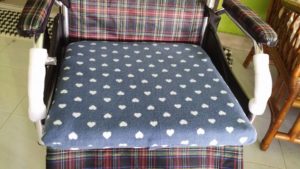When I feel stressful, sometimes I like to sew beads on my baju kurung. But I am too lazy to restock the beads so, whatever left is not enough to embellish my baju kurung. I am trying to spring clean my room (a wish that I have since January) but like always, I find some of the things that I have stashed away (on my last spring clean). I found a left-over fabric from my late mom’s baju kurung and a polka dot black-and-white fabric that I bought last year (for my other project that has never been materialised).
I watched Youtube on how to make lunch bag, pouch and and such. I came across a video showing how to make a hand-sewn small pouch. So, I gathered all the materials that I needed after maghrib yesterday and I started to sew around 8 pm until 10 pm and I continued to finish sewing this morning.
a) 
a) All you need are a piece of fabric (the sizes depend on your preference) – 4 pieces and a zipper. The tools that you need are a needle, thread and scissor (for cutting)
b) 
Align the different pieces of fabric together with the zipper and sew it together.
c) 
Flip the stitched fabric and make sure the same fabric are stitched together. Make sure you keep the zipper open. When you sew the edges of the same fabric together, leave a small space (not sew together) as an opening so that you can flip the pouch like picture D below through the opening.
d)  ‘
‘
After you flip the pouch inside out, sew the opening.
e) 
The end product. I put my stationery, official stamp and such inside. I always want to have a small pouch like this. The one that I can buy have different sizes and materials that I don’t prefer. So, creating my own pouch ticks every single requirement that I want to have on a small pouch. Satisfaction guaranteed.














